The Volta Ball Python is a unique, clinal variation of the species said to be bigger than the rest. Let’s take a closer look…
Volta Ball Pythons come from the Volta region of eastern Ghana, where they regularly reach larger sizes than their counterparts from other areas. Females especially can be at least 1000g heavier. In this article, we’ll look at just how different they are, and how to use them in breeding projects.
What is a Volta ball python?
A Volta Ball Python is not a morph, nor is it a subspecies. It is simply a Ball Python that comes from the Volta region, where they tend to get bigger, stockier and heavier than in other places.
Some people call them “sub-Saharan” which is accurate really, because the region they inhabit is just below the Sahara. Technically speaking, they are sub-Saharan, and when people say this they don’t mean just anywhere further south than the Sahara, they literally mean right below it.
That said, there are many sub-Saharan Ball Pythons in neighbouring countries, and even in other parts of Ghana, that don’t reach the same size as the Volta population. In fact, there’s also Ball Pythons in the Volta region that are normal sized!
Understandably, this gets a little confusing. However, what you need to remember is that when breeders say Volta these days, what they are usually referring to is the population of bigger animals native to the region. Double check before you buy anything!
Where are they from?
Volta Ball Pythons are named after a mountainous region in eastern Ghana which is dominated by lake Volta, the largest artificial reservoir in the world.
This region is rugged, and has what is known as a tropical savannah climate – making it just as mild as equatorial regions. Where it differs from the rainforest, for example, is that it has a distinct dry and wet season.
Here, you can find a variety of picturesque mountains and waterfalls, a geography that may have influenced the size of the Ball Pythons there. More on this later, though…

How big do Volta ball pythons get?
There are a lot of what I call “perspective photos” out there of Voltas. By this I mean someone holding the snake out in front of them, making it look absolutely ginormous in comparison. Often you get a caption that says something like “check out my GIANT Ball Python!”.
Obviously, this is kind of a big-fish-story way of going about things, but the truth is that they are actually pretty huge when compared to BPs from other regions. Not Burmese Python size, like you might expect from the photos, but big nonetheless.
So far, this website can confirm Volta Ball Pythons at 5’6’’ (1.68M), as measured by reliable sources. These animals were unanimously over 4000grams, and some over 5000g!
At the same time, many keepers and breeders say that they think 6 feet in length is possible for these snakes, though no confirmed cases have been reported so far.
Despite numerous accounts of Volta Ball Pythons reaching 6 feet or more, no one has been able to supply proof as of yet. In the author’s opinion, there probably is no such thing as a 6 foot+ Python regius – wherever it might be from.
That said, let’s remind ourselves that 5’6” is HUGE for a Ball Python. A 5’6” Rat Snake is fairly impressive, but it looks like a bread stick compared to a BP of the same length.
Volta vs normal Ball Python
As we’ve already explained, Voltas get bigger and heavier than other Ball Pythons. They tend to have stocky bodies, and incredibly broad, massive-looking heads.
From what I’ve seen, they also tend to be a little darker in colouration than many others. Notwithstanding, you can always brighten them up with appropriate genes like Orange Dream, Pastel or Desert Ghost.
This increased size is cool – buy why all the fuss? Part of the fuss is that instead of simply producing larger eggs, Voltas also tend to produce more of them. In fact, there is nothing unusual about a Volta female laying 15 eggs.
Last time I did an average across around fifty reported clutch sizes in both scientific studies and private breeders the result was 7. That means one Volta can produce more eggs than two normal BPs in a single clutch.
Why some populations are larger than others
The extra-large snakes from the Volta region are a classic example of clinal variation. Clinal variation occurs when a species occupies a large geographic range.
A cline is a little bit of variation in an animal’s characteristics in a part of that range, which isn’t quite enough to make a new species or subspecies. Across that distribution, parts of the population are subjected to different conditions than others, and this can change their phenotype (their appearance, morphology, etc.).
Generally, the effect is on what we call continuous traits, such as size and weight (when that trait is polygenetic, rather than just controlled by one gene). In the montane areas of eastern Ghana where Voltas live, they obviously encounter different conditions to other Ball Pythons.
These could be:
- drier conditions due to coastal winds
- less/more abundant prey
- larger prey
- less/more predators
- less/more parasites
- less/more competition with other species
- something different altogether!
We may never know, at least until a very in-depth study is carried out. It is worth mentioning that in most cases though, clinal variation is enhanced by partial isolation which limits gene flow.
Something any biologist will tell you is that animals that get separated from the rest of their species eventually diverge. The montane region may simply be making it harder for Volta Ball Pythons to exchange genes with the rest of the population, which could be just as much a cause for clinal variation as whatever conditions may be present.

Breeding tips
Now that I’ve put you all to sleep with my Volta ponderings, let’s get to the important part and talk about how to use them in breeding projects. Evidently, bigger snakes with more eggs = more profits, whatever you do with them. There are a couple of other things to consider though.
1. Their clutches are often 100% bigger than those of normal Ball Pythons. This means they are exceptionally useful for recessive projects.
To put this is perspective, imagine you breed a 100% het Clown, 100% Pied to a 100% het Clown, 100% het Pied. The probability of producing a very valuable Clown Pied baby is only one in sixteen.
So, in a normal seven-egg clutch you’d have a probability of less than 50% of making one. In a big, 15 egg Volta clutch, on the other hand, that probability goes up to 93.75%! Getting Voltas into recessive projects is definitely worth it in the long run.
2. Their larger clutches will quickly produce a lot of incomplete dominant or dominant morphs.
This one’s a double-edged sword. Producing a shedload of Confusion, Stranger or Acid babies in a single season sounds great. And if you can sell them – it is.
The problem is that you might flood the market, and drive down the price of that morph more quickly than ever. If it’s a really new and expensive gene, you may have trouble selling them all too.
If you have a lot of followers, and lot of clout, then go for it! If not, be careful.
Volta Ball Pythons for sale and price
You can find Volta Ball Pythons for sale on a fairly regular basis now. Darren and Jo, who kindly provided the video for this post, produce them every year here in the UK.
In the US, outlets like Outback Reptiles also work with them on a regular basis and will generally have some for sale.
As far as prices go, they aren’t expensive. A simple Volta, i.e., without any other genes involved will set you back as little as $125 – 200.
Also on this topic:
- How long does it take for a Ball Python to grow? (and how care affects size)
- How big do Ball Pythons get?
For more on Ball Python size in general:
Back to the Ball Python size page
